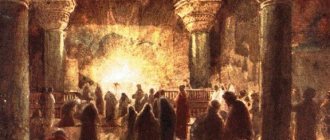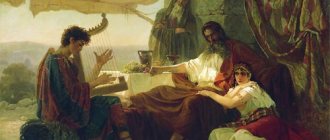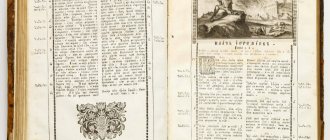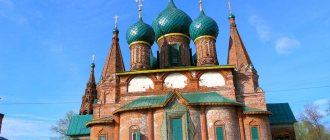Recommended for publication
Publishing Council of the Russian Orthodox Church
IS R16-521-1022
Scientific editors
Andrey Vinogradov,
priest Mikhail Zheltov
Divine Liturgy of St. John Chrysostom: with parallel translation into Russian / Ed. Metropolitan Hilarion (Alfeev) of Volokolamsk. – Moscow: Nikeya, 2021. 978-5-91761-784-8
© TD Nikeya LLC, 2021 © Nikeya Publishing House, 2017
Priest Afanasy Gumerov, resident of the Sretensky Monastery, answers:
The liturgy includes prayers that the priest reads not aloud, but “secretly.” Only their endings are pronounced as exclamations. At this time, those praying in the church listen to chants performed on the choirs. According to the professor of the Moscow Theological Academy A.A. Golubtsov, the practice of secret reading of prayers arose in the 5th century (“On the reasons and time of replacing the public reading of liturgical prayers with secret ones. - Theological Bulletin, 1905, September). St. Emperor Justinian made efforts to return to the ancient tradition. In chapter 6 of the 137th novella (565) it was prescribed: “We command that bishops and presbyters should not secretly pronounce the prayers of the Divine Offering and Holy Baptism, but in a voice that would be heard by the faithful people, so that the minds of those listening are aroused to greater remorse...”. However, these decisions could not stop the changes that were taking place. Some hidden, but very strong factors were at work. By the 8th century in the East, the secret reading of liturgical prayers had become almost universal. Apparently, this inevitable process was caused by profound changes within the church body. Briefly, this can be described as a transition from the church-communal conciliarity of the apostolic age to parish life in the modern sense. Liturgy is a common cause (Greek leitos - public, ergon - business). In the primal Church, the Eucharist was truly a common affair for every Christian. There was no right or left chorus. Everyone present sang. The entire community responded to the prayer of the priest and the petitions offered by the deacon. Everyone was united not only by common prayer, but by living and joyful participation in the great Sacrament, which was experienced as the real presence of the Lord, giving His Flesh and Blood to everyone present. Just as it is now unthinkable for a priest performing the liturgy not to receive communion, it was then impossible for someone present during the Eucharist to avoid receiving the Holy Mysteries of Christ. “There is one bread, and we, many, are one body; For we all partake of one bread” (1 Cor. 10:17). With the victory of Christianity and the formation of a new empire, nominal Christians began to enter the Church more and more. Eucharistic conciliarity weakened. A noticeable manifestation of this was the avoidance of many from communion. The Council of Antioch (341), based on the 9th Apostolic Canon, decreed: “All who enter the church and listen to the sacred scriptures, but, due to some deviation from order, do not participate in prayer with the people, or turn away from the communion of the Holy Eucharist “Let them be excommunicated from the church until they confess, show the fruits of repentance, and ask for forgiveness, and thus be able to receive it” (2nd rule). Gradually, among the church people there became more and more people who did not experience the liturgy as the main event of their spiritual life. “The greatest prayer of the Church - the Eucharistic, which in ancient times many knew by heart, began to be forgotten by the laity. Hence the disputes about its content noted by liturgists. Most laity do not feel the heartbeat of the Church, as it is heard in the anaphora, in which all the prayers of the Church “for everyone and for everything” are merged, about the transformation of the world and about the Kingdom of God. Anaphoras of the liturgies, and between them the prayer of St. Basil the Great, amaze with the scope of the worldwide cosmic prayer, into which the thanksgivings and petitions of certain members of the Church flow, the depth and power of the gracious love of the Church, the accuracy and plasticity of dogmatic formulas. This hymn of conciliar prayer does not reach the ears and consciousness of believers. For many, the understanding of the sacrificial nature of the Eucharist and the consciousness of responsible participation in the offering of the anaphora have been lost, although prosphoras and the submission of notes for the living and the dead (ancient diptychs) testify to this side of the Eucharistic common cause. Many people praying in church during the anaphora pray their own independent prayer, and not a congregational prayer, thank God for their
joys, bring their sorrows to Him and ask Him for help in
their
needs. The assembly of believers, unfortunately, does not recognize itself as unanimous and like-minded and united before the paten, at which the whole Church and the world surround the Head - Christ. In the attitude of the laity to the Eucharist and Liturgy, there is an element of conciliar, social decay, which is aggravated by the sin of rare communion. This is complicity in social sin, the sin of dislike for one’s neighbor” (B. Sove. The Eucharist in the Ancient Church and Modern Practice, - collection Living Tradition, M., 1997, pp. 213-14).
Many of those who receive communion in our time do not realize the great significance of the Bloodless Sacrifice, which is offered during the Eucharist. If they had been aware of this, they would not have asked immediately after the liturgy to commemorate the living or the dead (serve a memorial service or lithium). After all, there is no higher than liturgical commemoration. “In the words, “we thank the Lord,” all the tension of gratitude of the entire prayer meeting should be concentrated. At this moment everyone should realize their entire Eucharistic nature, that is, gratitude to God. Therefore, by such a denial of this Eucharisticity, i.e. The very meaning of the Liturgy is the request of the person who was present at the Liturgy and heard these words to serve him a thanksgiving
prayer service, because it is clearer to him, closer and says more to him than the most sublime service of thanksgiving - the Eucharist.
It is so inexpressibly sad to hear these requests for a prayer service of thanksgiving after the Liturgy, that is, in other words, instead of the Liturgy, which, therefore, says nothing to the soul of the person who wants to thank God. By the way, in general, serving any services
after the Liturgy is so contrary to the spirit of our worship!” (Archimandrite Cyprian (Kern). Eucharist, M., 2001, p. 314).
Throughout history, there have been attempts by individuals or groups of clergy to make changes to existing practices in the celebration of the liturgy. Thus, the renovationist Bishop Antonin (Granovsky) in the early 1920s served “a liturgy reviewed according to the ranks of ancient liturgies.” He brought the throne to the solea. But all this was done arbitrarily, and life canceled these innovations. On the contrary, the great shepherds (Saints John of Kronstadt and Alexy Mechev, Archpriest Valentin Amfitheatrov, etc.), sensitive to church life, without changing anything in the ritual aspect, performed the liturgy with that gracious inspiration that spiritually revived tens of thousands of people.
January 28, 2005
Types of Liturgy
In the modern Orthodox Church there are three main rites of the Liturgy:
– Liturgy of St. John Chrysostom. It is celebrated all year round, except during Lent and on Palm Sunday. In its content, it practically does not differ from the liturgy of St. Basil, but some prayers are shortened;
Saint John Chrysostom writes:
“Think, what honor have you received? What kind of meal do you enjoy? What the angels look at with trepidation and do not dare to look at without fear because of the radiance emanating from here, with this we are nourished, with this we communicate and become one body and one flesh with Christ.”
– The Liturgy of St. Basil the Great is served only 10 times a year. January 1 (on this day the Church remembers the saint who created this rite), January 6, January 18. And also on the first five Sundays of Great Lent, on Maundy Thursday and Great Saturday of Holy Week.
– Liturgy of the Presanctified Gifts. The rite of this liturgy was compiled by Gregory Dvoeslov, Pope of Rome, in the 6th century. The peculiarity of this liturgical rite is that the Sacrament of the Eucharist is not celebrated directly at the service at which believers receive communion. The Holy Gifts are consecrated in advance at the full Liturgy on Sunday and are stored in a special ark. Its emergence was marked by the fact that Christians, during days of strict fasting, considered it inappropriate to perform a solemn service. But in order for believers to have the opportunity to receive communion on weekdays, it was decided to use the Presanctified Gifts. It is performed only during Lent.
After the start of the Great Litany, the choir begins to sing antiphons
Then the great litany begins. What it is? At this time, the deacon leaves the altar through the side door and in front of the closed royal doors says: “Let us pray to the Lord in peace.” At this moment the choir sings, “Lord, have mercy.” Then the choir sings antiphons.
The first is “bless my soul the Lord,” the second is “praise the Lord my soul,” the third is “in your kingdom, remember us, Lord.” Before singing “in your kingdom...”, the royal doors open, and the priest reads prayers at this time. In these prayers, he asks the Lord to take care of the temple and those people who pray in it.
Next is the small entrance with the gospel. A priest comes out of a side door, raises the Gospel high and baptizes everyone gathered.
The priest makes the small entrance with the Gospel
Then he enters the altar through the royal doors. This is how the morning liturgy begins. Next, the choir begins to sing “come, let us worship and fall before Christ.” At this time, people bow, then sing troparia and kontakion.
Then the Trisagion is sung. It contains the following words: “Holy God, Holy Mighty, Holy Immortal, have mercy on us,” they are repeated three times. At this moment, people cross themselves and bow. The apostle reads next. An altar boy comes out of the altar with a book and stands in front of the pulpit. He turns towards the altar and begins to read. After reading the Apostle, the priest reads the Gospel. After the reading of the Gospel, a special litany begins, after which the royal doors are closed.
In this photo, the altar boy is reading the apostle
The interpretation of the proskomedia is that it is dedicated to the events of gospel history
What does proskomedia consist of? Let's consider its interpretation. Proskomedia is dedicated to the events of gospel history, which is why all the words and actions of this part of the service have a double meaning. On the one hand, this is the birth of Our Lord Jesus Christ, and on the other, his suffering and death.
In the church, the atoning sacrifice of Jesus Christ on Mount Calvary and the Eucharist performed in the temple are one and the same thing, that is, one and the same sacrifice.
This is how the Liturgy of Proskomedia is celebrated
Proskomedia is performed on the altar, which is located in the altar. At this time, the preparation of prosphoras is underway. The priest cuts out particles in honor of the patriarch and the ruling bishop, as well as all Orthodox Christians who are mentioned in church notes submitted by parishioners before the start of the service.
Then he leaves the altar and begins to walk around the temple. He walks around the entire temple with a censer and reads the 50th psalm of repentance to himself.
What is the Liturgy of the Catechumens? Consider the order of worship here. Before the start, the priest and deacon pray in the altar at the same altar. The deacon asks the priest for a blessing. This means that everything humanly possible has been done in the liturgy. Then the priest says loudly: “...blessed is the Kingdom of the Father and the Son and the Holy Spirit, now and ever and unto ages of ages.”
Next, all the lamps in the temple are lit.
During the special litany, all unbaptized people must leave the temple
Even in the first centuries of Christianity, all unbaptized people left the temple during a special litany. Only baptized Orthodox Christians remained in the church. Currently, Orthodox services are held in the same way. But only those who know about it leave the temple unbaptized.
The deacon exclaims, “Come out, ye catechumens, come out...”, so he says so that only faithful people remain. After this, the Cherubic song is sung. At this moment, not only the angels of the Lord serve together with the priest at the altar, but everyone in the temple has the opportunity to praise the Lord together with the Cherubim and Seraphim.
Next, a priest comes out of the altar with the Holy Chalice, a deacon with a censer and altar servers with candles and candlesticks stand in front. At this moment, the priest commemorates the patriarch, the diocesan bishop, and all Orthodox Christians. Then he enters the royal doors, and then they close. This is called the great entrance to the liturgy.
The priest brings out the Holy Mysteries of Christ after the Cherubic Song
At this moment, the holy laurels are taken out, which are transferred from the altar to the throne, to be sacrificed to the Lord. Then the priest places them on the throne and quietly reads the texts about the removal of Jesus Christ and his burial.







